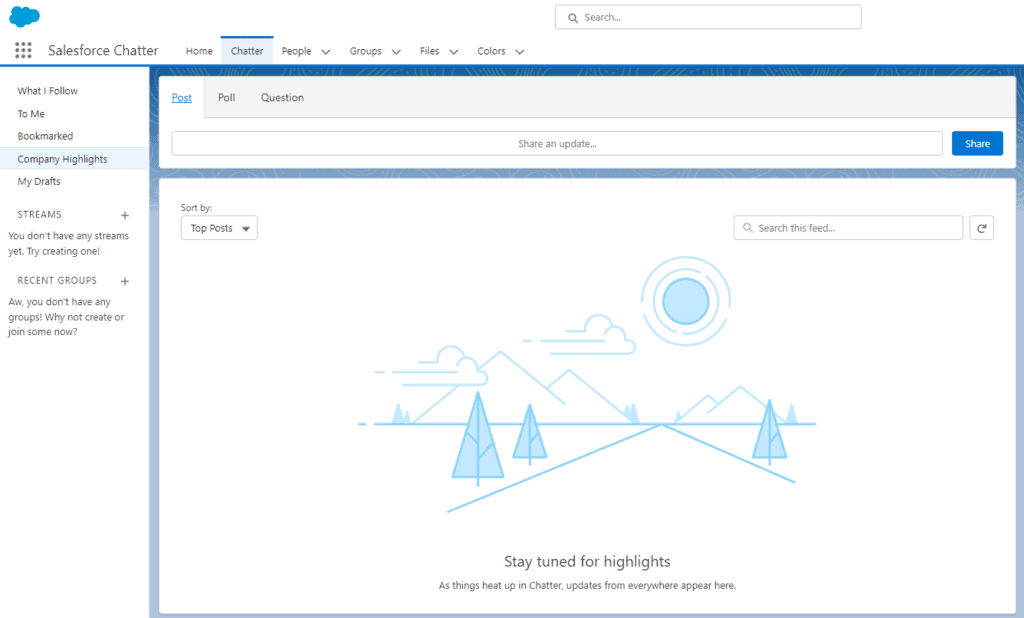Salesforce Chatter is a collaboration tool built into the Salesforce user interface. It allows employees, partners, and customers to communicate, collaborate, and innovate in a secure environment. With Chatter, users can share updates, create, share, and organize files, and collaborate on sales opportunities, service cases, campaigns, and projects with embedded apps and custom actions.
Chatter has its own page, and users can access different views of their Chatter feeds from the left side of the page. The Chatter feed displays posts, comments, and likes from people and records that users follow.
Users can also use Chatter to create groups, which are collections of people and records that users can collaborate with. In addition, Chatter allows users to mention other users or records in their posts, which sends a notification to the mentioned user or record.
Salesforce Chatter is available in different editions of Salesforce, and its features, benefits, and use cases vary depending on the edition. Chatter is enabled by default for all users in Salesforce organizations created after June 22, 2010.
However, Chatter can be disabled or enabled for specific users or profiles, and its settings can be customized to meet the organization’s needs.
Table of Contents
- Understanding Salesforce Chatter
- Key Features of Salesforce Chatter
- Salesforce Chatter for Business Processes
- Enhancing Team Collaboration with Salesforce Chatter
- Salesforce Chatter for Customer Engagement
- Salesforce Chatter for Knowledge Sharing
- Using Salesforce Chatter for Innovation and Ideas
- Salesforce Chatter in Marketing and Campaigns
- Salesforce Chatter in Community and Discussions
- Salesforce Chatter Notifications and Updates
- Salesforce Chatter for Productivity and Efficiency
- Salesforce Chatter Pricing and Implementation
- Salesforce Chatter Frequently Asked Questions
- How can I enable Chatter in Salesforce Lightning?
- What are some examples of how Chatter is used in Salesforce?
- What is the difference between Chatter and Feed in Salesforce?
- What are some benefits of using Salesforce Chatter?
- How do I receive notifications for Salesforce Chatter?
- Where can I find documentation for Salesforce Chatter?
Understanding Salesforce Chatter

Salesforce Chatter is an enterprise social network and collaboration software that allows companies to share information, collaborate, and stay updated with the latest updates within their organization.
Chatter is built into the Salesforce user interface, making it easily accessible and intuitive for users to grasp. It provides context where and when teammates need it, allowing employees to collaborate in real-time, exchange files, and just chat.
Chatter features include feeds, profiles, groups, and more. Users can view profiles, share files, join groups, and post updates. Chatter Free users can connect with people on their verified company email list.
Chatter is available in both Salesforce Classic and Lightning Experience editions. It is a cloud-based platform that allows users to access their data from anywhere, at any time, on any device.
RELATED RESOURCE: How To Customize The Look And Feel of Salesforce
Key Features of Salesforce Chatter

Chatter Feeds
Chatter Feeds are the heart of Salesforce Chatter. They allow users to post updates, share files, and collaborate with other users within the organization. Users can post updates on their own profile or on other users’ profiles.
They can also post updates on groups, records, and topics. Chatter Feeds provide a real-time view of what’s happening within the organization, allowing users to stay up-to-date with the latest information.
Chatter Groups
Chatter Groups are a way for users to collaborate on specific projects or topics. Users can create public or private groups, invite other users to join and share files and updates within the group. Chatter Groups provide a central location for users to collaborate on projects and share information.
Chatter Tab
The Chatter Tab is a central location for users to access their Chatter Feeds, Groups, and other Chatter-related features. It provides a real-time view of what’s happening within the organization, allowing users to stay up-to-date with the latest information.
File Sharing
File sharing is a key feature of Salesforce Chatter. Users can share files within Chatter Feeds, Groups, and other Chatter-related features. This allows users to collaborate on projects and share information without having to send files via email.
Private Groups
Private Groups are a way for users to collaborate on specific projects or topics in a secure environment. Only invited users can access the group, ensuring that sensitive information is kept private.
Topics
Topics allow users to categorize Chatter Feeds and other Chatter-related features. This makes it easier for users to find information and collaborate on specific topics. Users can follow topics to stay up-to-date with the latest information.
Salesforce Chatter for Business Processes

One of the key benefits of Chatter is its ability to connect to business processes. By integrating Chatter with other Salesforce products, businesses can automate their workflows and make their processes more efficient.
For example, sales opportunities and cases can be automatically assigned to the right team member, and updates can be sent to the appropriate stakeholders in real time.
Chatter can also be used to manage projects, especially critical projects that require constant collaboration and communication between team members. With Chatter, team members can easily share project updates, files, and feedback, and stay on top of deadlines and milestones.
In addition, Chatter can be used to manage orders and other critical business processes. By integrating Chatter with Salesforce’s order management system, businesses can ensure that orders are processed quickly and efficiently and that all relevant stakeholders are kept up-to-date on the status of each order.
Enhancing Team Collaboration with Salesforce Chatter

With Chatter, teams can collaborate in real time, exchange files, and just chat. It provides a centralized location for team members to communicate, share ideas, and work together on projects.
This helps to increase productivity and efficiency, as team members can easily stay up-to-date with the latest developments and collaborate on tasks without having to switch between multiple tools or platforms.
Sales teams can benefit from Chatter by using it to share information about leads, deals, and customers. This allows team members to stay informed about the latest sales opportunities and collaborate on strategies to close deals.
Chatter can also be used to track progress on sales goals and share best practices for selling products or services.
Product teams can use Chatter to collaborate on product development, share ideas, and track progress on projects. They can use Chatter to share product specifications, design mockups, and feedback from customers. This helps to ensure that everyone on the team is on the same page and working towards the same goals.
Colleagues can use Chatter to stay connected and share information about their work. They can use Chatter to share news, updates, and ideas with their colleagues, and to ask for feedback or advice. This helps to foster a culture of collaboration and teamwork, which can lead to better outcomes for the organization as a whole.
Salesforce Chatter for Customer Engagement

One of the key benefits of using Salesforce Chatter for customer engagement is that it enables customers to connect with each other.
This can help to build a sense of camaraderie and shared experience, which can be particularly valuable for customers who are dealing with similar challenges or who have similar interests. By facilitating these connections, companies can help to create a more engaged and loyal customer base.
In addition to connecting customers with each other, Salesforce Chatter also enables companies to engage with their customers directly. By creating a private social network, companies can provide customers with a platform to ask questions, provide feedback, and share ideas.
This can help to build a more collaborative relationship between the customer and the company and can help to improve the overall customer experience.
Salesforce Chatter also enables companies to create a more customer-focused company culture. By providing employees with a platform to share information and collaborate with customers, companies can foster a sense of customer-centricity that can help drive innovation and improve customer satisfaction.
This can help to create a more cohesive and effective customer company that is better equipped to meet the needs of its customers.
Salesforce Chatter for Knowledge Sharing

One of the key benefits of using Chatter for knowledge sharing is that it provides a centralized location for all of the information that a team needs.
Users can create groups based on specific topics or projects, and then share files, posts, and comments within those groups. This makes it easy for team members to find the information they need quickly and efficiently.
Another benefit of using Chatter for knowledge sharing is that it can help teams learn and grow. Chatter provides a platform for users to ask questions and receive answers from experts within their organization.
This can be particularly useful for new employees who are still learning the ropes, as it allows them to quickly get up to speed on company processes and procedures.
Salesforce also offers a variety of training resources through its Trailhead platform, which can be accessed directly through Chatter. This makes it easy for users to learn new skills and stay up-to-date on the latest industry trends.
Finally, Chatter can also be integrated with Salesforce’s Experience Cloud, which allows organizations to create custom communities for their customers, partners, and employees. This can be a powerful tool for knowledge sharing, as it allows users to connect with a wider network of experts and share information with a larger audience.
Using Salesforce Chatter for Innovation and Ideas

One of the key benefits of using Chatter for innovation is that it allows employees to share their ideas and feedback in real time. This means that teams can quickly iterate on concepts and make adjustments based on feedback from their colleagues.
By enabling a more agile approach to innovation, Chatter can help companies bring new products and services to market faster and more efficiently.
Another advantage of using Chatter for innovation is that it allows employees to collaborate across departments and geographies. By breaking down silos and facilitating cross-functional communication, Chatter can help teams generate new ideas and solutions that might not have been possible otherwise.
This can be especially valuable for companies that operate in complex or highly regulated industries, where innovation often requires input from a wide range of stakeholders.
To get the most out of Chatter for innovation, it’s important to create a culture of openness and collaboration within the organization. This means encouraging employees to share their ideas and feedback, and providing them with the tools and resources they need to do so effectively.
It also means being willing to experiment and take risks, and being open to feedback and criticism from colleagues.
Salesforce Chatter in Marketing and Campaigns

One of the key benefits of Chatter in marketing and campaigns is the ability to create groups focused on specific campaigns or projects.
This allows team members to collaborate more effectively and share updates and ideas in real-time. By using Chatter to keep everyone on the same page, teams can work more efficiently and effectively towards campaign goals.
Another way Chatter can be used in marketing and campaigns is through the sharing of brand assets. By creating a Chatter group specifically for brand assets, team members can easily access and share logos, images, and other important brand materials. This ensures that all team members are using the correct materials and messaging, which is crucial for maintaining a consistent brand image.
In addition to collaboration and asset sharing, Chatter can also be used to track campaign progress and results. By creating a Chatter feed specifically for campaign updates, team members can easily share information on how campaigns are performing, what strategies are working, and what changes need to be made.
This makes it easier to adjust campaigns as needed and ensure that marketing efforts are as effective as possible.
Salesforce Chatter in Community and Discussions

Chatter in Communities allows for public discussions to take place in a forum-style setting. Users can create and participate in discussions on various topics, which can be organized into categories.
This allows for easy navigation and discovery of relevant content. Users can also follow discussions to receive notifications when new posts are added.
Next-gen communities take this a step further by allowing for more personalized and interactive discussions. Users can create their own profiles and connect with others who share similar interests. This creates a sense of community and fosters engagement among users.
Portals can also benefit from Chatter by allowing for public discussions to take place. This can be useful for customer support, as customers can ask questions and receive responses from other customers or support staff. This can help to reduce the workload on support staff and provide more timely responses to customers.
Salesforce Chatter Notifications and Updates

Salesforce Chatter provides users with real-time updates and notifications to stay informed about the latest activities. Users can receive notifications for updates to records, groups, and people they follow. Additionally, users can choose to receive email notifications for specific Chatter actions.
Chatter notifications are customizable, allowing users to choose which updates they receive and how often they receive them. Users can opt to receive notifications for posts, comments, likes, mentions, and more. They can also choose to receive notifications immediately, daily, or weekly.
Notifications can be viewed in the Chatter feed, as well as in the notifications tab. Users can mark notifications as read or unread, and they can also delete notifications they no longer need.
Updates in Chatter are displayed in a feed format, similar to social media platforms. Users can post updates, share files, and comment on posts. All updates are visible to users who follow that person or record. Users can also mention other users in their posts and comments using the @ symbol.
In addition to updates and notifications, Chatter also provides users with the ability to filter their feed to see specific updates. Users can filter their feed by record type, group, or person. They can also search for specific keywords to find updates related to a particular topic.
Salesforce Chatter for Productivity and Efficiency

One of the key benefits of Chatter is its ability to facilitate real-time collaboration. With Chatter, team members can share ideas, ask questions, and provide feedback in a timely manner, without the need for lengthy email chains or in-person meetings.
This can help teams move projects forward more quickly, reducing the time and resources required to complete tasks.
Chatter can also improve data management and organization. By providing a single platform for sharing and storing information, Chatter can help teams avoid duplication and ensure that everyone is working with the most up-to-date data. This can help reduce errors and improve the accuracy of project deliverables.
In addition, Chatter can help teams stay organized and on track. By providing tools for task management, scheduling, and project tracking, Chatter can help teams stay focused on their goals and ensure that deadlines are met.
This can help improve overall team efficiency and reduce the risk of missed deadlines or incomplete tasks.
Salesforce Chatter Pricing and Implementation

Salesforce Chatter is available as a feature in various Salesforce editions, including Professional, Enterprise, Performance, and Unlimited.
Pricing
Salesforce Chatter is included in all Salesforce editions at no additional cost. However, to access certain features such as Chatter Plus, additional fees may apply. Chatter Plus is a paid add-on that includes more advanced features such as external collaboration and access to custom objects.
Implementation
Implementing Salesforce Chatter is relatively straightforward and can be done in a few simple steps. First, administrators need to enable the feature in their Salesforce organization. They can then customize Chatter settings and permissions to suit their specific needs.
After enabling Chatter, users can start collaborating by posting updates, sharing files, and creating groups. Chatter also allows users to follow people, records, and groups to stay up-to-date on the latest information.
To ensure successful implementation, it is important to train users on how to use Chatter effectively.
Salesforce provides extensive documentation and training resources to help users get started with Chatter.
Salesforce Chatter Frequently Asked Questions
How can I enable Chatter in Salesforce Lightning?
To enable Chatter in Salesforce Lightning, go to Setup > Feature Settings > Chatter > Chatter Settings. From there, you can enable Chatter feed tracking, email notifications, and other settings related to Chatter.
What are some examples of how Chatter is used in Salesforce?
Chatter can be used in a variety of ways in Salesforce. For example, team members can use Chatter to collaborate on projects, share documents, and provide feedback on tasks. Sales reps can use Chatter to share information about leads and opportunities, and customer service teams can use Chatter to quickly resolve customer issues.
What is the difference between Chatter and Feed in Salesforce?
Chatter is a social collaboration tool that allows users to share information and communicate with each other in real time. Feed, on the other hand, is a feature in Salesforce that displays a list of updates and activities related to a specific record or object. While Chatter allows users to collaborate and communicate with each other, Feed is more focused on providing a timeline of updates related to a specific record or object.
What are some benefits of using Salesforce Chatter?
Some benefits of using Salesforce Chatter include improved collaboration, increased productivity, and better communication among team members. Chatter allows users to share information and collaborate in real time, which can help streamline workflows and reduce the need for email communication. Additionally, Chatter can help improve team morale and foster a sense of community among team members.
How do I receive notifications for Salesforce Chatter?
To receive notifications for Salesforce Chatter, go to your Chatter settings and enable email notifications. You can also receive notifications through the Salesforce mobile app, which will send push notifications when new updates are posted.
Where can I find documentation for Salesforce Chatter?
Salesforce provides extensive documentation for Chatter on its website. You can find documentation on how to use Chatter, how to customize Chatter settings, and how to troubleshoot common issues. Additionally, Salesforce offers a community forum where users can ask questions and get help from other users.